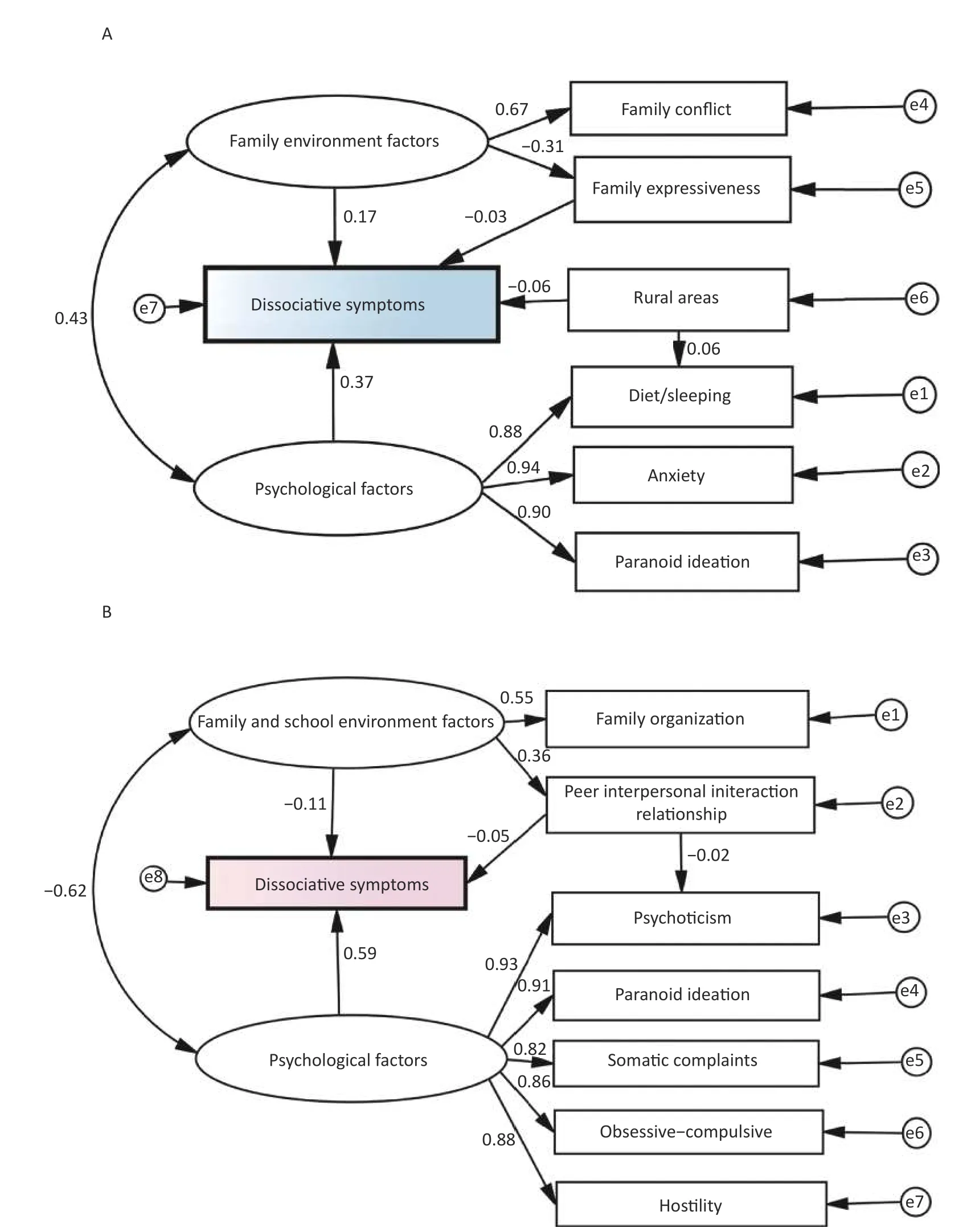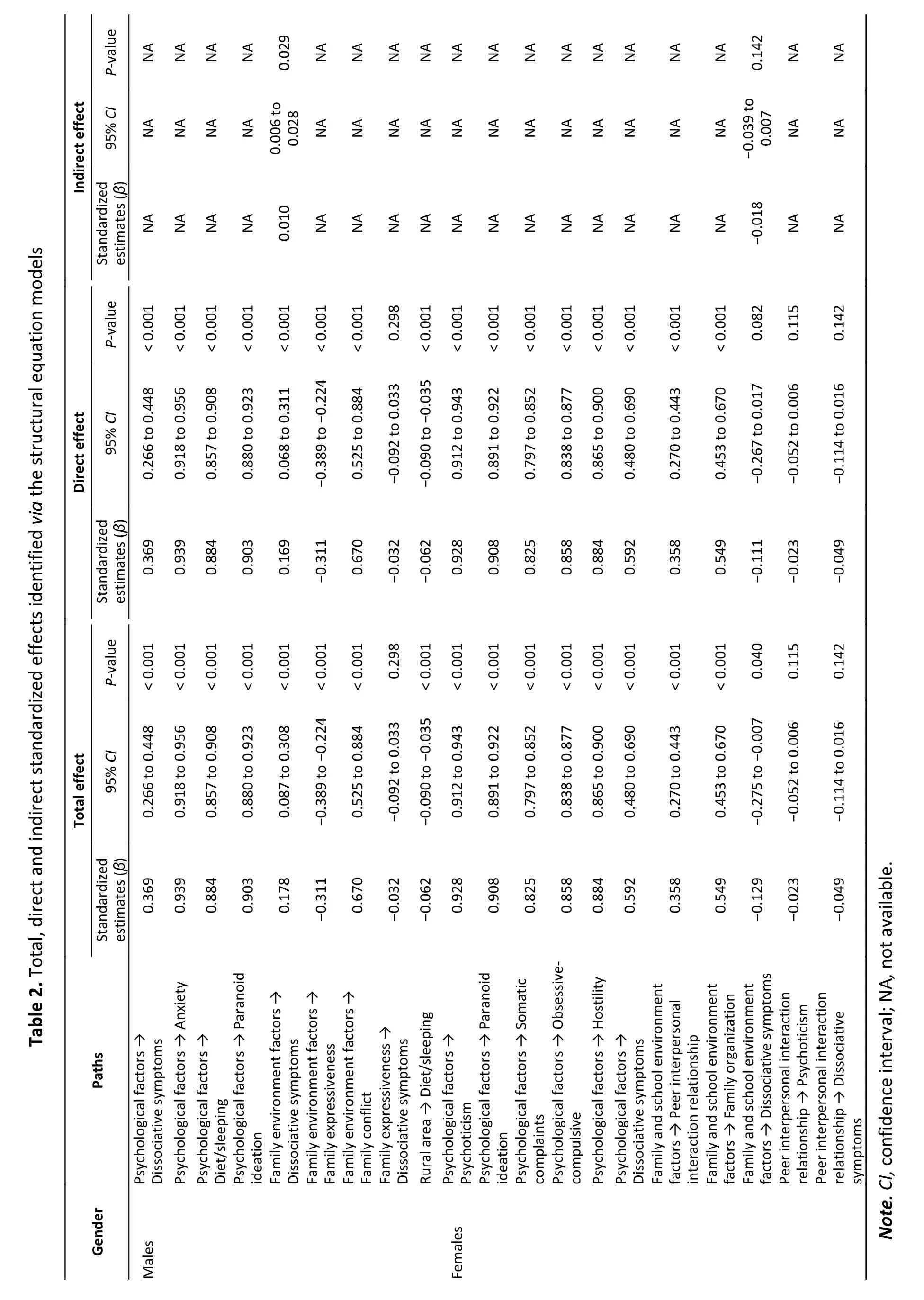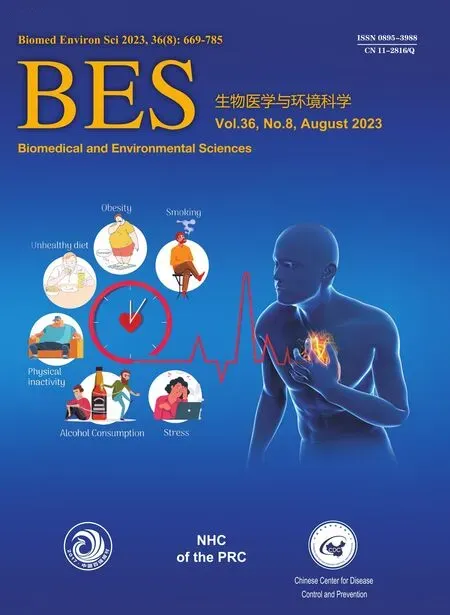Exploring Gender Differences in Adolescent Dissociative Symptoms via A Structural Equation Model*
CHENG Qing Lin ,DENG Yuan Yuan ,ZHAO Gang ,CHEN Jun Fang ,XIE Li ,and WANG Le
Adolescent dissociative disorders (ADDs) have been recognized as significant psychological issues with an estimated prevalence of 45.2% in psychiatric outpatient clinics[1]. Previous studies have demonstrated that dissociative symptoms (DSs)manifest as early signs of dissociative disorders(DDs)[2].DSs are characterized as aberrations in one's feelings,experiences,and thoughts in the realm of awareness and memory[3].DSs with high dissociation scores primarily present with memory disturbances,emotional constriction,depersonalization,and identity alterations[3]. Studies have indicated that adolescent dissociative symptoms (ADSs) can lead to a range of unfavorable outcomes,including DDs,antisocial personality disorder,alcohol use disorder,and non-suicidal self-injury[4]. These findings establish a link between ADSs and their adverse consequences and,thus,highlight the critical role of early sign identification in ADDs[2,4]. Moreover,evidence suggests that the effective identification and prevention of ADSs can significantly influence the incidence and development of psychiatric disorders in adolescence[2-4].
To date,we still lack a fully precise approach to interventions in ADSs at a sex-stratified level.Clinicians and families require gender-specific information necessary to monitor adolescent mentality growth. Our previous study,based on student populations,suggested that the development of ADSs during the COVID-19 pandemic was the result of a multifactorial combination of sociodemographic and psychological traits and environmental factors[5].Unfortunately,we did not explore the interaction effects among independent impact factors of gender-specific ADSs.To bridge these gaps,we performed a gender-specific study of ADSs using a structural equation model (SEM) to investigate the direct and interactive effects of ADSs and multiple impact factors by gender stratification.Several studies have confirmed that SEM is a system of linear equations that can be visually described using path diagrams.SEM was used to examine the relationship between the implied conditional dependency among variables and to estimate whether the covariance structure of the empirical data matched the structure implied by the multivariate model.
We employed a multistage random sampling survey method to determine the sample size for our study.A final sample size of 2,700 was calculated,considering the number of participants lost during follow-up,rejection rate,sampling error,and stratification factors.We performed a school-based,cross-sectional,multicenter study in Hangzhou City,China,from January 1,2021 to June 30,2022.Using a multiphase,stratified,and cluster sampling technique,we randomly selected mainstream adolescents aged 13-18 years who were fluent in Chinese.Individuals with a history of psychosis or neurocognitive deficits or those who received secondary mental health services were excluded from the study.Supplementary Figure S1 (available in www.besjournal.com) provides further details on the sampling process used in our study.
We employed standard scales to screen for ASDs and assess their impact on social,family and school environments and mental health status(Supplementary Table S1,available in www.besjournal.com). The ADSs are estimated using a two-stage appraisal procedure.In the first stage,we used the Adolescent Dissociative Experience Scale(A-DES)[6]and assessed severity based on the mean score of all A-DES items (score range: 1-10 points;higher scores indicate greater severity).Participants with a mean score of three or more were identified as having ADSs[6].Our previous study confirmed that the A-DES has high reliability and validity,with a Cronbach’s alpha coefficient of 0.97[5].In the present sample,internal consistency was 0.91.In the second stage,individuals identified as having ADSs were evaluated by three psychiatrists for a final diagnosis.The investigators included psychiatrists,medical students,and school healthcare personnel,all of whom were uniformly trained. Approximately 60 trained investigators administered two questionnaires (i.e.,the A-DES and the Diagnostic and Statistical Manual of Mental Disorders,fifth edition) to subjects who were assessed as having ADSs. Face-to-face evaluations and investigations were performed by the investigators. The study utilized three trained investigators in each School Health Surveillance System (SHSS) center to ensure the research process quality.
In our multicenter cross-sectional study,we analyzed 2,427 subjects. The response rate was 89.89% (2,427/2,700).The male-to-female sex ratio was 1.06:1 (1,249/1,178).The average age of our participants was 15.49 ± 1.64 years. There were 1,678 (69.14%) and 749 (30.86%) participants,respectively,in rural and urban areas.The overall positivity rate of ADSs was 22.46% (545/2,427) in Hangzhou. Among adolescents with ADSs,the positivity rate was 18.68% (220/1,178) and 26.02%(325/1,249) for female and male participants,respectively.Our analysis revealed that adolescent dissociative scores were higher in male participants,with at-value of 3.57 (P<0.001).Similarly,the positivity rate of ADSs was also higher in male participants with a chi-square value of 18.78 (P<0.001) (Table 1).

Table 1. Baseline characteristics of subjects (N=2,427)
We conducted linear regression analyses using the ADSs scores as the dependent variable and sociodemographic characteristics,environmental factors,and psychological variables as independent variables.Supplementary Table S2 (available in www.besjournal.com) summarizes the results of univariate analyses of the impact factors of ADSs by gender stratification.Among the 39 variables tested,28 (e.g.,left-behind adolescents,social adaptation,family cohesion,and somatic complaints) were associated with male ADSs (P<0.05).Meanwhile,11 variables (e.g.,age,teacher-student positive relationships,family independence,and family control) were not associated with male ADSs(P>0.05).Female ADSs were associated with 29 variables (e.g.,academic achievement,study and life adaptation,teacher-student positive relationships,family conflict,and psychoticism) (P<0.05) and had no link to 10 other variables (e.g.,rural areas,family independence,family control) (P>0.05).Significant factors were included in the stepwise multiple linear regression analyses stratified by gender (P<0.05).
Stepwise multiple linear regression analyses stratified by gender,indicated that realistic external factors,such as psychological (i.e.,anxiety,diet/sleeping,and paranoid ideation),family (i.e.,family expressiveness and family conflict),and rural areas appeared to only impact male ADSs.Psychological factors include psychoticism,paranoid ideation,somatic complaints,obsessivecompulsiveness,and hostility; family (i.e.,family organization) and school factors (i.e.,peer interpersonal interaction relationship) were associated with female ADSs only (Supplementary Table S3,available in www.besjournal.com).
Based on the multiple linear regression models described above,we designed SEMs for both male and female ADSs as shown in Figure 1.The SEM model fit indices indicated that the proposed models fit the data accurately,with a comparative fit index (CFI) of 0.996,goodness-offit index (GFI) of 0.994,root mean square error of approximation (RMSEA) of 0.034,Akaike’s Information Criterion (AIC) of 60.472,and Bayes Information Criterion (BIC) of 152.814 for male ADSs.Similarly,the fitted SEM indicator values for female ADSs were within the recommended values,with CFI =0.989,GFI =0.982,RMSEA =0.061,AIC = 125.961,and BIC = 227.393(Supplementary Table S4,available in www.besjournal.com).

Figure 1. The structural equation models of dissociative symptoms among adolescents (A,males;B,females).
The male SEM model suggests that various factors such as family conflict,family expressiveness,rural areas,anxiety,diet/sleeping,and paranoid ideation play crucial roles in predicting male ADSs.Psychological factors in the male SEM model included anxiety,diet/sleeping,and paranoid ideation,which were positively associated with ADSs[standardizedβ=0.369,standard error (SE)=0.021,P< 0.001]. Family environment factors,such as family conflict and expressiveness,were also found to contribute to DSs (standardizedβ=0.169,SE =0.121,P=0.013).Extensive research has indicated that family conflict and expressiveness are key variables that affect DSs[7].This is because the family environment is an essential source of emotional support for adolescents,and those without such support are predisposed to poor moods and adverse events. Furthermore,the study found that participants from rural areas were more prone to ADSs (standardizedβ=0.058,SE=0.125,P=0.021).This finding is consistent with earlier observations that depressive tendencies are associated with rural areas[8]. Interestingly,an interaction effect was found between family environmental and psychological factors (standardizedβ=0.429,SE =0.250,P<0.001).Diet/sleeping had a direct effect on male ADSs by affecting rural areas (standardizedβ=-0.062,P=0.001) (Figure 1A,Table 2,and Supplementary Table S5,available in www.besjournal.com). In summary,the male SEM identified several critical predictors of male ADSs,including family conflicts and expressiveness,rural areas,anxiety,diet/sleeping,and paranoid ideation.This study highlights the importance of family environments in supporting adolescents’ emotional well-being,especially among those living in rural areas. Additionally,the findings demonstrate the complex interplay between various factors that contribute to ADSs,emphasizing the need for comprehensive interventions that simultaneously address multiple factors.
Unlike the male SEM model,the pathways in the female SEM model indicated a significant association between psychological factors (i.e.,psychoticism,paranoid ideation,somatic complaints,obsessivecompulsive symptoms,and hostility) and ADSs(standardizedβ= 0.592,SE = 0.014,P< 0.001).Previous research has identified common mental disorders such as anxiety and somatoform as risk factors for DSs[2,3]. These disorders can lead to physical discomfort and decreased immune function,significantly affecting the quality of life of adolescents and exacerbating DSs. The female SEM also highlighted family and school environment factors(i.e.,family organization and peer interpersonal interaction relationships) as related to ADSs(standardizedβ=-0.129,P=0.040).Moreover,the study showed an interaction effect (standardizedβ=-0.621,SE=0.323,P<0.001) between psychological factors and family and school environment factors for ADSs (Figure 1B,Table 2,and Supplementary Table S5).As such,gender differences in ADSs were significant in this SEM. Further exploration is necessary to understand these differences,which may be attributed to the cognitive-emotional needs of adolescents of different genders. Compared to their male counterparts,female adolescents may be more inclined to seek peer support and information[9].These findings have crucial implications for developing gender-specific intervention strategies for ADSs.

Notably,our SEM models indicated that poor psychological conditions were the strongest predictor of both male (total standardizedβ=0.369,P< 0.001) and female (total standardizedβ=0.592,P< 0.001) ADSs (Figure 1,Table 2,and Supplementary Table S5).Gender differences have a significant psychological impact on ADSs. For instance,anxiety and diet/sleeping were associated only with male ADSs,while hostility,psychoticism,somatic complaints,and obsessive-compulsive behaviors were related only to female ADSs. A previous study in the United States suggests that DSs can be a pathway through which anxiety is associated with suicidal ideation[2].Additionally,the present findings might be in accordance with studies showing that the mental health of male adolescents was more likely to be influenced by sociodemographic and family environmental factors(e.g.,rural area,family conflict,and family expressiveness)[8,10]; Correspondingly,the mental health of female adolescents was more associated with school and family environmental factors (e.g.,peer interpersonal interaction relationship and family organization).Thus,there is an urgent need to develop targeted intervention policies and programs from a gender lens.Several studies have shown that dissociation plays a significant role in eating and sleep disorders[2].These findings further support the association between diet/sleeping and male ADSs.In contrast to male ADSs,female ADSs seemed to be more affected by mental factors. Consequently,female adolescents with poor mental health status require more attention.
This study has several limitations,largely due to the limitations of the available data.First,we could not confirm causal associations in this cross-sectional study,which could only evaluate associations between ADSs and observed factors.Second,our sample comprised only adolescents from Hangzhou City.Therefore,our results cannot be extrapolated to the entire adolescent population.Third,we need to further explore the risk factors for ADSs in future longitudinal studies.
Ethical ApprovalStudies involving human participants were reviewed and approved by the Ethics Committee of the Hangzhou Center for Disease Control and Prevention.Written informed consent to participate in this study was obtained from the participants’ legal guardians or next of kin.
Author ContributionCHENG Qing Lin and DENG Yuan Yuan designed the study.CHENG Qing Lin and ZHAO Gang conducted the statistical analyses and wrote the first draft of the manuscript.CHENG Qing Lin,DENG Yuan Yuan,ZHAO Gang,CHEN Jun Fang,XIE Li,and WANG Le conducted field research. All the authors contributed to the manuscript and approved the submitted version.
AcknowledgmentWe would like to thank the participants and their guardians for kindly participating in this study,as well as the staff members of the six schools included in the study for their help in the field investigation of ADSs.We also thank all field investigators for supplying the epidemiological data in Hangzhou City.
Conflicts of InterestNo potential conflicts of interest were disclosed.
#Correspondence should be addressed to CHENG Qing Lin,Tel/Fax: 86-571-88000505. E-mail: chenghzcdc@sina.com;DENG Yuan Yuan,E-mail: dengyuanyuan@stu.hznu.edu.cn
Biographical notes of the first authors: CHENG Qing Lin,male,born in 1977,PhD,Chief Physician,majoring in public health research related to emergent crisis;DENG Yuan Yuan,female,born in 1998,MA,majoring nutritional epidemiology.
 Biomedical and Environmental Sciences2023年8期
Biomedical and Environmental Sciences2023年8期
- Biomedical and Environmental Sciences的其它文章
- The China Cardiovascular Health Index 2023 was Grandly Released
- Method for Vitamin D Deficiency Screening
- Method for Folate Deficiency Screening
- A Campylobacteriosis Outbreak Caused by One Asymptomatic Food Handler Carrier*
- A Risk Assessment Model for Pancreatic Cancer Based on Cuproptosis-related Genes and Clinical Characteristics
- Risk of Developing Non-Alcoholic Fatty Liver Disease Over Time in a Cohort of the Elderly in Qingdao,China*
